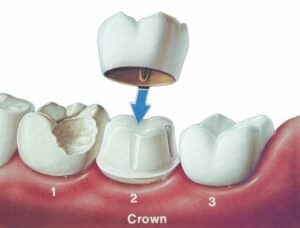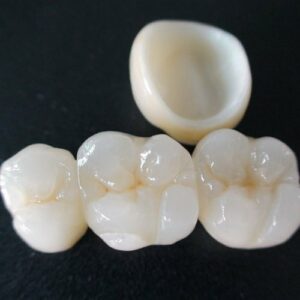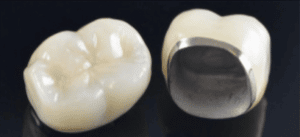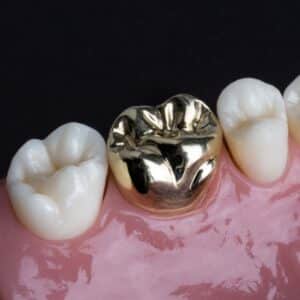
1.Broken tooth requires crown. 2.Tooth is reshaped to allow placement of crown. 3.Crown fabricated in lab is cemented into place protecting the underlying tooth from further damage.
If you have teeth that have been heavily filled, cracked, or have undergone root canal treatment, dental crowns can be an excellent solution to restore the strength and functionality of those teeth. By fitting snugly over the affected tooth, crowns provide a protective barrier that helps to reinforce and hold the tooth together and prevent further damage.
Crowns are also a great option for improving the appearance of teeth that are worn down, misshapen, or discolored. Whether due to grinding or acid erosion, dental crowns can be custom-made to match the shape, size, and color of your natural teeth, resulting in a beautiful, seamless smile.
At our practice, we use the highest-quality materials and advanced techniques to create durable and natural-looking crowns that blend seamlessly with your existing teeth. Our cutting-edge 3D scanning technology allows us to digitally design a crown that will fit perfectly in your mouth. Whether you need a single crown or multiple crowns to restore your smile, we’re here to help you achieve optimal oral health and function.
 Full porcelain crowns are a popular choice for patients seeking a natural-looking and aesthetically pleasing solution for damaged or discolored teeth. There are two main types of full porcelain crowns: E.Max (lithium-disilicate) and Zirconia. E.Max is an excellent choice for front teeth where translucency
and its natural look is important, while Zirconia is preferred for posterior teeth where more strength is needed to withstand biting forces.
It’s important to note that full porcelain crowns may require more tooth reduction compared to other types of crowns, such as gold crowns, to achieve the same level of strength and durability.
At our practice, we offer a comprehensive consultation to help you understand the benefits and drawbacks of each type of crown. Our goal is to help you make an informed decision that meets your individual needs and preferences, while also providing you with the highest quality dental care possible.
Full porcelain crowns are a popular choice for patients seeking a natural-looking and aesthetically pleasing solution for damaged or discolored teeth. There are two main types of full porcelain crowns: E.Max (lithium-disilicate) and Zirconia. E.Max is an excellent choice for front teeth where translucency
and its natural look is important, while Zirconia is preferred for posterior teeth where more strength is needed to withstand biting forces.
It’s important to note that full porcelain crowns may require more tooth reduction compared to other types of crowns, such as gold crowns, to achieve the same level of strength and durability.
At our practice, we offer a comprehensive consultation to help you understand the benefits and drawbacks of each type of crown. Our goal is to help you make an informed decision that meets your individual needs and preferences, while also providing you with the highest quality dental care possible.

Porcellain fused to metal crown
 Gold crowns are made from a special gold alloy, making them an ideal choice for patients who prioritize minimal reduction of their natural tooth structure. One downside of gold crowns is that they lack the outer covering of porcelain that gives them a natural tooth color, which some patients may find aesthetically unappealing. However, gold crowns can be an excellent option for posterior teeth, where strength and durability are key, and where the aesthetic appearance of the tooth may not be as important.
Gold crowns are also known for their resistance to decay and other issues, making them a durable and long-lasting option for patients. At our practice, we will discuss the specific benefits and drawbacks of gold crowns with you, as well as other types of crowns, to help you make an informed decision that meets your individual needs and preferences.
Gold crowns are made from a special gold alloy, making them an ideal choice for patients who prioritize minimal reduction of their natural tooth structure. One downside of gold crowns is that they lack the outer covering of porcelain that gives them a natural tooth color, which some patients may find aesthetically unappealing. However, gold crowns can be an excellent option for posterior teeth, where strength and durability are key, and where the aesthetic appearance of the tooth may not be as important.
Gold crowns are also known for their resistance to decay and other issues, making them a durable and long-lasting option for patients. At our practice, we will discuss the specific benefits and drawbacks of gold crowns with you, as well as other types of crowns, to help you make an informed decision that meets your individual needs and preferences.
